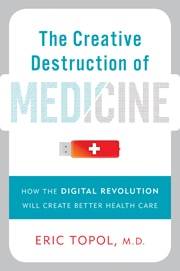New Book, 'The Creative Destruction of Medicine,' Describes How Digital Revolution Will Create Better Health Care
Author Eric Topol outlines the biggest shakeup in the history of medicine

In “The Creative Destruction of Medicine: How the Digital Revolution Will Create Better Health Care,” Dr. Eric Topol explores how digitization will change the medical field for professionals and patients.
San Diego – The inventions of cell phones, personal computers, and the Internet ushered in the digital revolution and altered our existence in ways that were unimaginable just a few decades ago. But the most precious part of our existence our health has so far been largely unaffected and insulated from these innovations.
Now, we are on the verge of a medical revolution. In “The Creative Destruction of Medicine: How the Digital Revolution Will Create Better Health Care” (Basic Books, available in hardcover Feb. 1, 2012), Eric Topol, MD introduces the digital future of medicine and explores how digitization will fundamentally change the medical field for both professionals and patients.
According to Dr. Topol, the chief academic officer of Scripps Health, we’re at perhaps the greatest convergence in our history: the rapidly maturing digital, nonmedical world of mobile devices, cloud computing, and social networking is finally coalescing with the emerging digital medical world of genomics, biosensors and advancing imaging.
Furthermore, the digital medical fields are already supplying a wealth of innovation. Pocket-sized ultrasound devices, at-home sleep monitors, and air strip technology that can measure everything from calorie intake to oxygen level are currently available. Nanosensors that can anticipate heart attacks and detect the first instance of cancer and breath sensors that can track lung cancer and asthma are in development. Similarly, the sequencing of the human genome has opened a new door in medical discovery; as sequencing becomes both faster and more affordable, Dr. Topol notes, it will become a routine procedure for every individual and the backbone of a patient’s medical history, determining both testing and treatment procedures.
Drawing on his own experience as a practicing cardiologist, as well as other case studies, Dr. Topol opens “The Creative Destruction of Medicine” by explaining how medicine works today: Treatments are based on the population, not the individual. Digital medicine including wireless sensors, genomics, imaging, and electronic health records and health information technology systems has the power to radically change that. “This is a new era of medicine, in which each individual can be near fully defined at the individual level, instead of how we practice medicine at a population level, with mass screening policies for such conditions as breast or prostate cancer and use of the same medication and dosage for a diagnosis rather than for a patient,” he writes.
Yet Dr. Topol acknowledges that there will be challenges along the way: physicians may be tempted to treat the scan or the DNA data, not the patient; the privacy and security of our data may be compromised; and ethical dilemmas and controversies may arise when, for example, a couple can screen for thousands of rare mutations they may carry before conceiving a baby. Yet Dr. Topol believes that the advantages of individualized medicine far outweigh any challenges we’ll face. By leveraging the science of individuality, doctors will be able to get the relevant digital readout from a person to fashion a therapy, instead of using a mass-population-directed strategy. “We now have the tools to do this on a broad basis throughout medicine and for the first time promote a level of prescription precision we have never seen before,” he writes.
“Our system has to change,” Dr. Topol concludes. “It has to reboot. We need creative destruction of the old rules.” In “The Creative Destruction of Medicine,” he shows the way to do just that.
About the author
Eric Topol, MD, is the chief academic officer of Scripps Health, director of the Scripps Translational Science Institute and co-founder and vice-chairman of the West Wireless Health Institute in La Jolla, California. He is a practicing cardiologist at the Scripps Clinic and a professor of genomics at The Scripps Research Institute.
One of the top ten most cited researchers in medicine, elected to the Institute of Medicine of the National Academy of sciences, named as one of the twelve Rock Stars of Science in GQ, Dr. Topol led many of the trials that have shaped contemporary treatment for heart disease.
About the book
“The Creative Destruction of Medicine: How the Digital Revolution Will Create Better Health Care” is available in hardcover on Feb. 1, 2012. For more information, see: Creative Destruction of Medicine
About Scripps Health
Learn more about Scripps Health, a nonprofit integrated health system based in San Diego, Calif.
Media Contact
- Keith Darce
- 858-678-7121
- darce.keith@scrippshealth.org